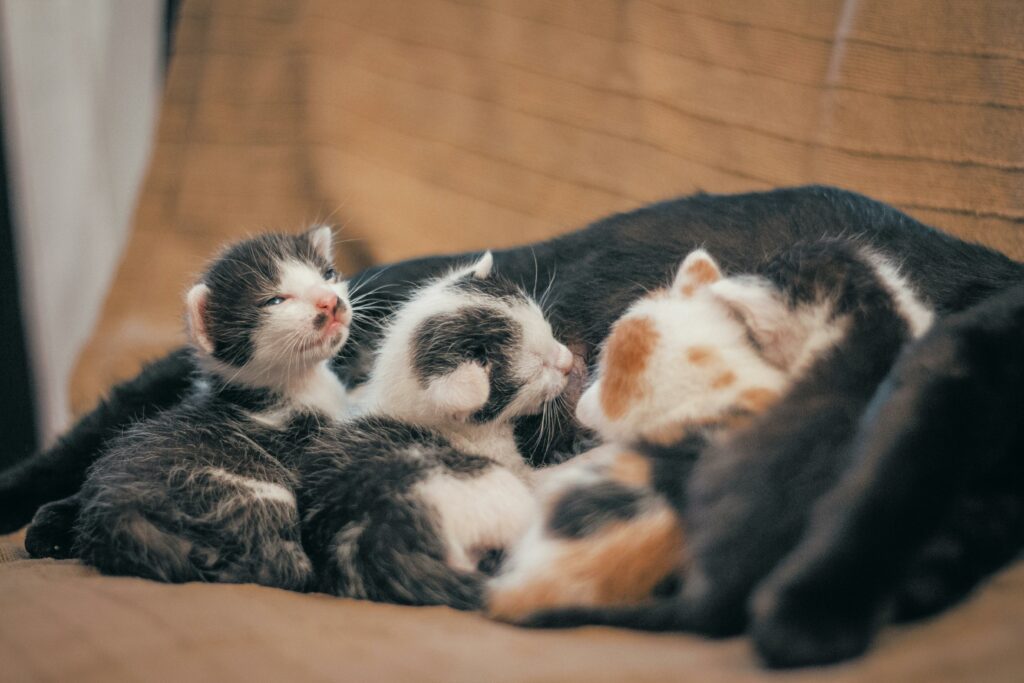Being aware of what to expect throughout your cat’s pregnancy is essential for the well-being of healthy kittens. Pregnant cats are usually independent caregivers who have raised kittens in the face of many hardships. To make the process safer for mother cats, pet parents can take a number of steps at home.
Signs of Cat Pregnancy
There are several tell-tale signs that point to your cat being pregnant. Her heat cycle stopping could be the first sign. Moreover, a pregnant cat may experience episodes of “morning sickness,” and as the pregnancy goes on, the cat will often eat more. At approximately five weeks, your cat’s stomach will be considerably larger, and it will keep getting bigger until she delivers birth. Her nipples might also seem enlarged and/or turn a deeper shade of red, called “pinking up.” Unlike dogs, cats don’t exhibit behavioral changes until much later in their pregnancies, though they may exhibit increased behavior related to grooming their breast and back areas as well as nesting – seen in the last week of pregnancy. Milk production usually occurs in the last week of pregnancy.
Scheduling a consultation with your veterinarian is the best way to find out if your queen is pregnant. There are several methods they can use to confirm and find out how many kittens are on the way. The ideal time to do an ultrasound is between 25 and 35 days pregnant. False-negative results appear before 21 days. However, it is important to note that the number of kittens your pregnant fur baby is carrying cannot be determined by ultrasound. Another tool that can be used is an Xray, which can help estimate how many kittens your cat will have, but they are not always reliable. You should wait to get an X-ray until your cat is at least 42 days pregnant, and it is usually not advised to wait until 55 days.
Cats take about two months to gestate, with an average of 63 to 65 days. The gestation period can be roughly divided into three “trimesters” lasting 20 days each, though it can be challenging to distinguish between the first two at home.
Although it varies by breed, cats typically have 4 kittens each litter. Note that litter size is not associated with the number of matings.
Care During Cat Pregnancy
Your pregnant queen might require extra food and energy during their pregnancy, much like many other expecting female animals in the animal kingdom. She must be fed high-quality kitten food or cat food intended especially for expectant mothers. Your cat will receive the correct nutrients in the right amounts if they are fed the right diet. Since your cat’s womb will be pressing on her stomach, it will be difficult for her to consume a large meal at once. Instead, offer her little meals throughout the day. According to Dr. Margaret V. Root Kustritz, DVM, the need for protein in the diet rises during pregnancy, particularly for the amino acids tryptophan, lysine, and arginine. Pregnant queens prefer diets strong in protein than those high in carbohydrates.
Vaccinate your pregnant fur buddy based on the recommended timetable since viruses can infect kittens before they are born. Consult your veterinarian to ensure if your pregnant cat can receive the recommended medicine or if their routine vaccination, deworming, and/or flea treatment are due. Since most vaccines are unsafe to administer while pregnant, it is preferable to receive vaccinations before breeding.
Don’t limit your cat’s exercise because her activity levels won’t vary significantly when she’s pregnant. Nonetheless, it is a good idea to keep her away from any sick or unfamiliar cats.
Preparing for Cat Birth
Timing and keen observation are the keys to providing your cat with excellent maternal care. It is advisable to observe the cat discreetly from a distance, being careful not to frighten or upset her. Speak with a veterinarian if any issues arise. There are three steps to birth, commonly known as parturition or kittening, with the second and third processes being repeated for every kitten.
In the first stage, there are intermittent contractions, but no straining is seen. Your pregnant queen may also be agitated, wherein she makes frequent and numerous trips to the bed. Some bedding scratching late in the first stage and one may notice panting.
Vaginal discharge is not common. The second stage is accompanied by abdominal contractions that coincide with productive uterine contractions and, in a typical parturition, lead to the fetuses’ expulsion. Lastly, the third stage involves the fetal membranes’ expulsion. The second and third phases frequently happen at the same time. The kittens should already be breaking out of the amniotic sac or membrane when they are first delivered. If the mother doesn’t assist them, you will need to very carefully cut it open in order to free the kitten. Usually, though, she will.
A placenta should also appear after each kitten. There may be an infection if the placenta is kept. Check if you have observed a placenta for every kitten by counting. It is normal for the mother to consume some or all of the placentas. This is both safe and entirely usual. You must again take the mother to the veterinarian right away if it looks like she may have retained a placenta.
Additionally, the umbilical cord is typically chewed off by the mother cat. You must assist her if she doesn’t. About an inch away from the kittens’ bodies, securely wrap a long, strong thread around the cord. An inch up the cord, tie another loop of thread, and then use a sharp pair of scissors to cut between the two loops.
The kittens should crawl to their mother’s nipples and start sucking as soon as they’ve been delivered and cleansed. It is safe to let your cat and her kittens to have some alone time at that moment. Best wishes on your new kitten litter!
Don’t forget to seek veterinary advice if you have any concerns.
















